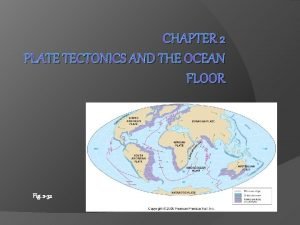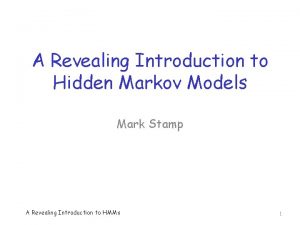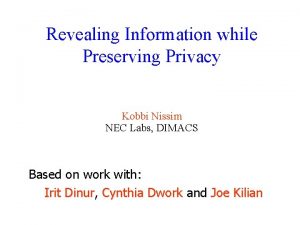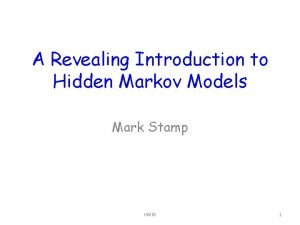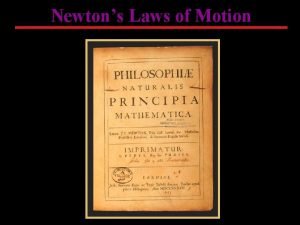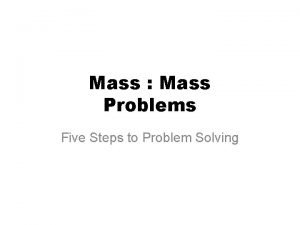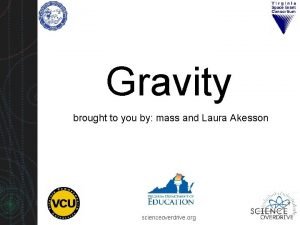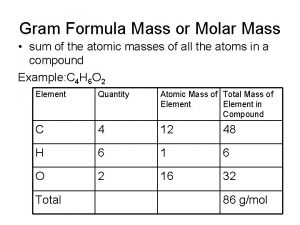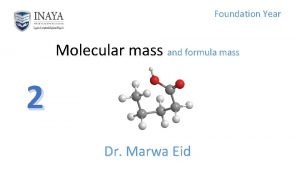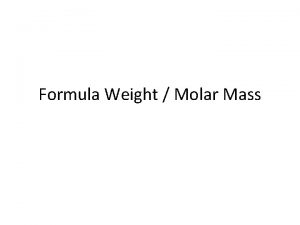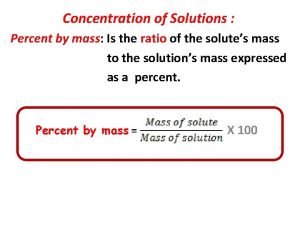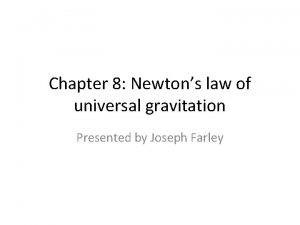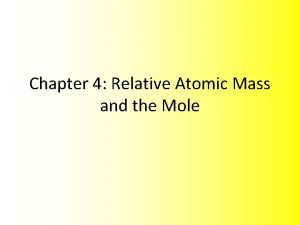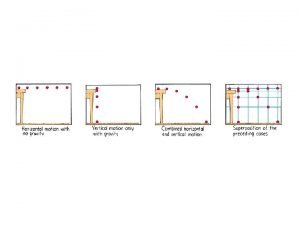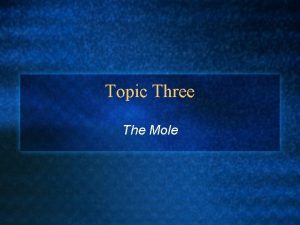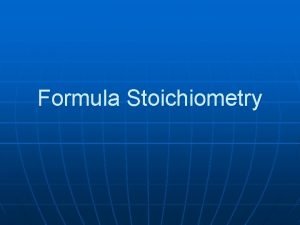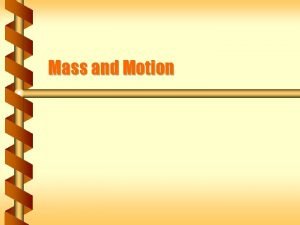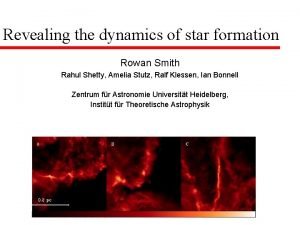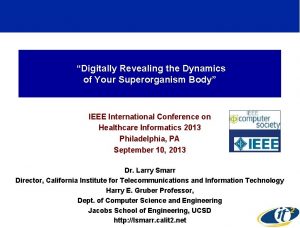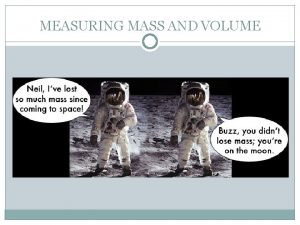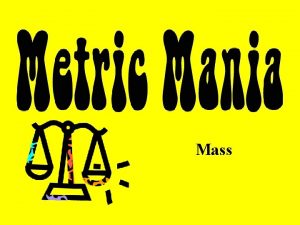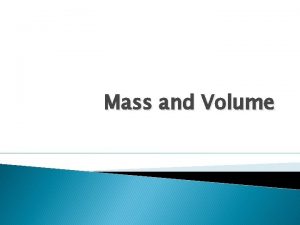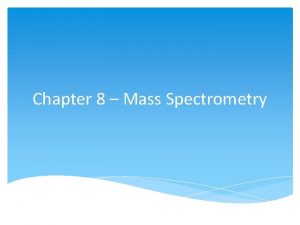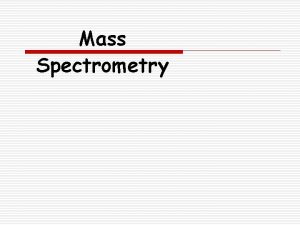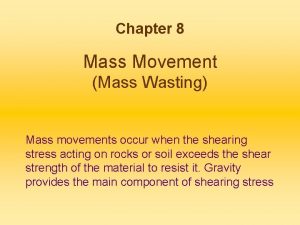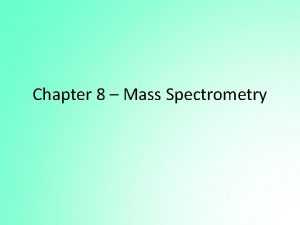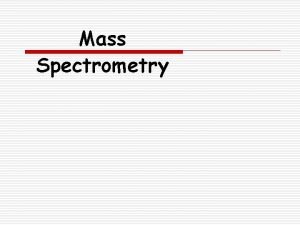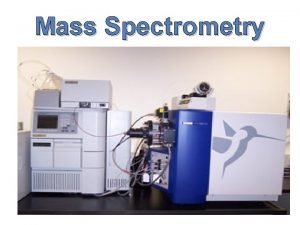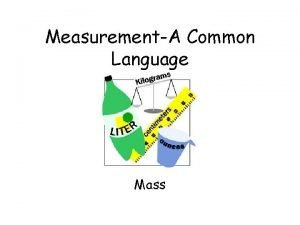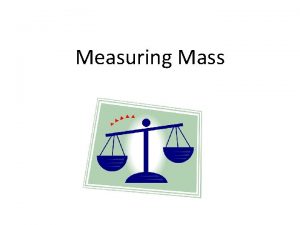and K Structure Revealing the Dynamics of Mass




































































- Slides: 68

π and K Structure: Revealing the Dynamics of Mass Generation Craig Roberts

Students, Postdocs, Profs. 1. 2. 3. 4. 5. 6. 7. 8. 9. 10. 11. 12. 13. 14. 15. 16. 17. 18. Jing CHEN (Peking U. ) Bo-Lin LI (Nanjing U. ) Ya LU (Nanjing U. ) Khépani RAYA (U Michoácan); Chien-Yeah SENG (UM-Amherst) ; Chen CHEN (UNESP, São Paulo & IIT-USTC); Zhu-Fang CUI (Nanjing U. ) ; J. Javier COBOS-MARTINEZ (U Michoácan); Minghui DING (Nankai U. ) ; Fei GAO (Peking U. ) ; L. Xiomara GUTIÉRREZ-GUERRERO (MCTP) Cédric MEZRAG (INFN-Roma, ANL, Irfu Saclay) ; Mario PITSCHMANN (Vienna); Si-xue QIN (CQU, ANL, U. Frankfurt am Main, PKU); Eduardo ROJAS (Antioquia U. ) Jorge SEGOVIA (TU-Munich, ANL); Chao SHI (ANL, Nanjing U. ) Shu-Sheng XU (Nanjing U. ) 19. 20. 21. 22. 23. 24. 25. 26. 27. 28. 29. 30. 31. 32. 33. 34. Adnan Bashir (U Michoácan); Daniele Binosi (ECT*) Stan Brodsky (SLAC); Lei Chang (Nankai U. ) ; Bruno El-Bennich (São Paulo); Tanja Horn (Catholic U. America) Yu-Xin Liu (PKU); Hervé Moutarde (CEA, Saclay) ; Joannis Papavassiliou (U. Valencia) M. Ali Paracha (NUST, Islamabad) Jose Rodriguez Qintero (U. Huelva) ; Franck Sabatié (CEA, Saclay); Sebastian Schmidt (IAS-FZJ & JARA); Peter Tandy (KSU); Shaolong WAN (USTC) ; Hong-Shi ZONG (Nanjing U) Craig Roberts. π and K Structure: Revealing the Dynamics of Mass Generation (68 p) 6 -10/11/17, ECT*: Dilepton Production 2 with Meson & Anti-p Beams

Emergent Phenomena in the Standard Model Existence of the Universe as we know it depends critically on following empirical facts: Ø Proton is massive, i. e. the mass-scale for strong interactions is vastly different to that of electromagnetism Ø Proton is absolutely stable, despite being a composite object constituted from three valence quarks Ø Pion is unnaturally light (but not massless), despite being a strongly interacting composite object built from a Emergence: low-level rules producing high-level valence-quark and valence antiquark Craig Roberts. π and K Structure: Revealing the Dynamics of Mass Generation (68 p) phenomena, with enormous apparent complexity 6 -10/11/17, ECT*: Dilepton Production with Meson & Anti-p Beams 3

Ø LHC has NOT found the “God Particle” because the Higgs boson is NOT the origin of mass – Higgs-boson only produces a little bit of mass – Higgs-generated mass-scales explain neither the proton’s mass nor the pion’s (near-)masslessness – Hence LHC has, as yet, taught us very little about • Origin Nature Structure of the nuclei whose existence support the Cosmos Ø Strong interaction sector of the Standard Model, i. e. QCD, is the key to understanding the origin, existence and properties of (almost) all known matter Ø Answers are in sight – Theoretical tools are reaching point where sound QCD predictions can be made – New facilities – in operation or being planned – can validate those predictions Craig Roberts. π and K Structure: Revealing the Dynamics of Mass Generation (68 p) 6 -10/11/17, ECT*: Dilepton Production with Meson & Anti-p Beams 4

Craig Roberts. π and K Structure: Revealing the Dynamics of Mass Generation (68 p) 5 6 -10/11/17, ECT*: Dilepton Production with Meson & Anti-p Beams

Perspective on the origin of hadron masses Craig D. Roberts, ar. Xiv: 1606. 03909 [nucl-th] Strong Interactions in the Standard Model of Particle Physics Ø Only apparent scale in chromodynamics is mass of the quark field Ø In connection with everyday matter, that mass is 1/250 th of the natural (empirical) scale for strong interactions, viz. more-than two orders-of-magnitude smaller Ø Quark mass is said to be generated by Higgs boson. Ø Plainly, however, that mass is very far removed from the natural scale for strongly-interacting matter Ø Nuclear physics mass-scale – 1 Ge. V – is an emergent feature of the Standard Model – No amount of staring at LQCD can reveal that scale Ø Contrast with quantum electrodynamics, e. g. spectrum of hydrogen levels measured in units of me, which appears in LQED Craig Roberts. π and K Structure: Revealing the Dynamics of Mass Generation (68 p) 6 -10/11/17, ECT*: Dilepton Production with Meson & Anti-p Beams 6

Whence Mass? Ø Classical chromodynamics … non-Abelian local gauge theory Ø Remove the current mass … there’s no energy scale left Ø No dynamics in a scale-invariant theory; only kinematics … theory looks the same at all length-scales … there can be no clumps of anything … hence bound-states are impossible. Ø Our Universe can’t exist Ø Higgs boson doesn’t solve this problem … normal matter is constituted from light-quarks & the mass of protons and neutrons, the kernels of all visible matter, are 100 -times larger than anything the Higgs can produce Ø Where did it all begin? … becomes … Where did it all come from? Craig Roberts. π and K Structure: Revealing the Dynamics of Mass Generation (68 p) 6 -10/11/17, ECT*: Dilepton Production with Meson & Anti-p Beams 7

Whence Mass? Ø Poincaré invariance entails that the Energy-Momentum Tensor is divergence-free, i. e. it defines a conserved current: Tμν can always be made symmetric Ø Noether current associated with a global scale transformation: x → e-σ x is the dilation current: Dμν=Tμν xν Ø In a scale invariant theory, the dilation current is conserved Ø Consequently, in a scale invariant theory the energy-momentum tensor must be traceless: Tμμ ≡ 0 Craig Roberts. π and K Structure: Revealing the Dynamics of Mass Generation (68 p) 8 6 -10/11/17, ECT*: Dilepton Production with Meson & Anti-p Beams

Trace Anomaly Ø Classical chromodynamics is meaningless … must be quantised Ø Regularisation and renormalisation of (ultraviolet) divergences introduces a mass-scale … dimensional transmutation: mass-dimensionless quantities become dependent on a mass-scale, ζ Ø α → α(ζ) in QCD’s (massless) Lagrangian density, L(m=0) QCD β function Under a scale transformation ζ → eσ ζ, then α → σ αβ(α) L→ σ αβ(α) d. L/dα ⇒ ∂μDμ = δL/δσ = αβ(α) d. L/dα = β(α) ¼Gμν = Tρρ =: Θ 0 Trace anomaly Ø Straightforward, nonperturbative derivation, without need for diagrammatic analysis … quantisation of renormalisable four-dimensional theory forces nonzero value for trace of energy-momentum tensor Craig Roberts. π and K Structure: Revealing the Dynamics of Mass Generation (68 p) 9 6 -10/11/17, ECT*: Dilepton Production with Meson & Anti-p Beams

Whence? Ø Classical chromodynamics … non-Abelian local gauge theory Ø Local gauge invariance; but there is no confinement without a mass-scale – Three quarks can still be colour-singlet – Colour rotations will keep them colour singlets – But they need have no proximity to one another … proximity is meaningless in a scale-invariant theory Ø Whence mass … equivalent to whence a mass-scale … equivalent to whence a confinement scale Ø Understanding the origin of mass in QCD is quite likely inseparable from the task of understanding confinement. Existence alone of a scale anomaly answers neither question Craig Roberts. π and K Structure: Revealing the Dynamics of Mass Generation (68 p) 6 -10/11/17, ECT*: Dilepton Production with Meson & Anti-p Beams 10

Craig Roberts. π and K Structure: Revealing the Dynamics of Mass Generation (68 p) 6 -10/11/17, ECT*: Dilepton Production 11 with Meson & Anti-p Beams

Trace Anomaly Ø Knowing that a trace anomaly exists does not deliver a great deal … indicates only that a mass-scale exists Ø Can one compute and/or understand the magnitude of that scale? Ø One can certainly measure the magnitude … consider proton: Ø In the chiral limit the entirety of the proton’s mass is produced by the trace anomaly, Θ 0 … In QCD, Θ 0 measures the strength of gluon self-interactions … so, from one perspective, mp is completely generated by glue. Craig Roberts. π and K Structure: Revealing the Dynamics of Mass Generation (68 p) 12 6 -10/11/17, ECT*: Dilepton Production with Meson & Anti-p Beams

Craig Roberts. π and K Structure: Revealing the Dynamics of Mass Generation (68 p) 13 6 -10/11/17, ECT*: Dilepton Production with Meson & Anti-p Beams

Trace Anomaly Ø In the chiral limit ⇒ Ø Does this mean that the scale anomaly vanishes trivially in the pion state, i. e. gluons contribute nothing to the pion mass? Ø That is a difficult way to obtain “zero” Ø Easier, perhaps, to imagine that “zero” owes to cancellations between different operator-component contributions to the expectation value of Θ 0. Ø Of course, such precise cancellation should not be an accident. It could only arise naturally because of some symmetry and/or symmetry-breaking pattern. Craig Roberts. π and K Structure: Revealing the Dynamics of Mass Generation (68 p) 6 -10/11/17, ECT*: Dilepton Production with Meson & Anti-p Beams 14

Whence “ 1” and yet “ 0” ? Ø No statement of the question “Whence the proton's mass? ” is complete without the additional clause “Whence the absence of a pion mass? ” Ø Natural nuclear-physics mass-scale must emerge simultaneously with apparent preservation of scale invariance in related systems – Expectation value of Θ 0 in pion is always zero, irrespective of the size of the natural mass-scale for strong interactions = mp Craig Roberts. π and K Structure: Revealing the Dynamics of Mass Generation (68 p) 15 6 -10/11/17, ECT*: Dilepton Production with Meson & Anti-p Beams

A New Era for hadro-particle physics Craig Roberts. π and K Structure: Revealing the Dynamics of Mass Generation (68 p) 6 -10/11/17, ECT*: Dilepton Production with Meson & Anti-p Beams 16

Model independent statement: There is quark orbital angular momentum in the pion Probable corollary: What is true in the pion, is true in the proton A New Era Ø QCD is the first place that we fully experience the collisions and collusions between relativity and quantum mechanics. Ø In attempting to match QCD with Nature, we confront the innumerable complexities of nonperturbative, nonlinear dynamics in relativistic quantum field theory, e. g. – the loss of particle number conservation, – the frame and scale dependence of the explanations and interpretations of observable processes, – and the evolving character of the relevant degrees-of-freedom. Ø Origin and distribution of mass, momentum, spin within hadrons, e. g. where is the proton’s spin and how is the pion spinless? – Don’t forget the latter! – How do all the spin-1/2 quarks and spin-1 gluons combine to make a massless, J=0 composite mode? Craig Roberts. π and K Structure: Revealing the Dynamics of Mass Generation (68 p) 6 -10/11/17, ECT*: Dilepton Production with Meson & Anti-p Beams 17

Ø What is origin of mass in our Universe? Ø What is the nature of confinement in real (dynamical -quarks) QCD? Ø How are they connected? Ø How can any – answers, – conjectures – and/or conclusions be empirically verified? Physics is an Empirical Science Craig Roberts. π and K Structure: Revealing the Dynamics of Mass Generation (68 p) 6 -10/11/17, ECT*: Dilepton Production with Meson & Anti-p Beams 18

Craig Roberts. π and K Structure: Revealing the Dynamics of Mass Generation (68 p) 19 6 -10/11/17, ECT*: Dilepton Production with Meson & Anti-p Beams

Particle Data Group Craig Roberts. π and K Structure: Revealing the Dynamics of Mass Generation (68 p) 20 6 -10/11/17, ECT*: Dilepton Production with Meson & Anti-p Beams

Pinch Technique: Theory and Applications Daniele Binosi & Joannis Papavassiliou Phys. Rept. 479 (2009) 1 -152 Craig Roberts. π and K Structure: Revealing the Dynamics of Mass Generation (68 p) 21 6 -10/11/17, ECT*: Dilepton Production with Meson & Anti-p Beams

Bridging a gap between continuum-QCD and ab initio predictions of hadron observables, D. Binosi et al. , ar. Xiv: 1412. 4782 [nucl-th], Phys. Lett. B 742 (2015) 183 -188 Ø Running gluon mass Ø Gluons are cannibals – a particle species whose members become massive by eating each other! In QCD: Gluons become massive! Expression of trace anomaly: Massless glue becomes massive gluon mass-squared function Power-law suppressed in ultraviolet, so invisible in perturbation theory 5% Interaction model for the gap equation, S. -x. Qin et al. , ar. Xiv: 1108. 0603 [nucl-th], Phys. Rev. C 84 (2011) 042202(R) [5 pages] Class A: Combining DSE, l. QCD and p. QCD analyses of Craig Roberts. π and K Structure: Revealing the Dynamics of Mass Generation (68 p) QCD’s gauge sector 22 6 -10/11/17, ECT*: Dilepton Production with Meson & Anti-p Beams

Massive Gauge Bosons! Ø Gauge boson cannibalism … a new physics frontier … within the Standard Model Ø Asymptotic freedom means … ultraviolet behaviour of QCD is controllable Ø Dynamically generated masses for gluons and quarks means that QCD dynamically generates its own infrared cutoffs – Gluons and quarks with wavelength λ > 2/mass ≈ 1 fm decouple from the dynamics … Confinement? ! Ø How does that affect observables? – It will have an impact in any continuum study – Possibly (probably? ) plays a role in gluon saturation. . . In fact, could be a harbinger of gluon saturation? Craig Roberts. π and K Structure: Revealing the Dynamics of Mass Generation (68 p) 6 -10/11/17, ECT*: Dilepton Production with Meson & Anti-p Beams 23

Ø All QCD solutions for gluon & quark propagators exhibit an inflection point in k 2 … consequence of the running-mass function Þ Spectral function is NOT positive Þ Such states have negative norm (negative probability) Þ Negative norm states are not observable Þ This object is confined! Confined particle Sum of “probabilities” Inflexion point Corresponds to r. C ≈ 0. 5 fm: Parton-like behaviour at shorter distances; but propagation characteristics changed dramatically at larger distances. mg ≈ 0. 5 Ge. V Craig Roberts. π and K Structure: Revealing the Dynamics of Mass Generation (68 p) 6 -10/11/17, ECT*: Dilepton Production with Meson & Anti-p Beams 24

Craig Roberts. π and K Structure: Revealing the Dynamics of Mass Generation (68 p) 25 6 -10/11/17, ECT*: Dilepton Production with Meson & Anti-p Beams

Quark Fragmentation Ø A quark begins to propagate Ø But after each “step” of length σ, on average, an interaction occurs, so that the quark loses its identity, sharing it with other partons Ø Finally, a cloud of partons is produced, which coalesces into colour-singlet final states meson σ Confinement is a dynamical phenomenon! Craig Roberts. π and K Structure: Revealing the Dynamics of Mass Generation (68 p) 6 -10/11/17, ECT*: Dilepton Production with Meson & Anti-p Beams 26

Quark Fragmentation meson Ø A quark begins to meson propagate meson a y l e h g t r i a w l Ø But after each “step” of s d i s te c c i e s n y n h o p c n y o l length σ, on average, han r e d t a a m i n t i n so enon, e interaction occurs, m e n m meson nfi o o n C e h. t p t that the quark loses its u o al ec f h c i f t i e m w l n a a d o n i r e y i t d d h a t c n identity, sharing itnwith l e a e h c e i m r g p m a a r r m n f a o y e c e d n h e othert partons g b a n f i o o d t n y n l i a t e g i s k r i r l o e n d e u n th Ø Finally, s i It aiscloud ofeously u h c i h n w a , t l g u partons is produced, eakin sim r. b ) y n r o t i e p which coalesces ( n o r symm into d a h s s a colour-singlet final states ro m ze σ Confinement is a dynamical phenomenon! Craig Roberts. π and K Structure: Revealing the Dynamics of Mass Generation (68 p) 6 -10/11/17, ECT*: Dilepton Production with Meson & Anti-p Beams 27

⇐ What’s happening out here? ! Craig Roberts. π and K Structure: Revealing the Dynamics of Mass Generation (68 p) 28 6 -10/11/17, ECT*: Dilepton Production with Meson & Anti-p Beams

QED Running Coupling Ø Quantum gauge field theories in four spacetime dimensions, – Lagrangian couplings and masses come to depend on a mass scale – Can normally be related to the energy or momentum at which a given process occurs. Ø QED, owing to the Ward identity: – a single running coupling – measures strength of the photon-charged-fermion vertex – can be obtained by summing the virtual processes that dress the bare photon, viz. by computing the photon vacuum polarisation. Ø QED's running coupling is known to great accuracy and the running has been observed directly. Craig Roberts. π and K Structure: Revealing the Dynamics of Mass Generation (68 p) 6 -10/11/17, ECT*: Dilepton Production with Meson & Anti-p Beams 29

Process independent strong running coupling Binosi, Mezrag, Papavassiliou, Roberts, Rodriguez-Quintero ar. Xiv: 1612. 04835 [nucl-th], Phys. Rev. D 96 (2017) 054026/1 -7 Process-independent effective-charge in QCD Ø Modern continuum & lattice methods for analysing gauge sector enable analogous quantity to be defined in QCD Ø Combined continuum and lattice analysis of QCD’s gauge sector yields a parameter-free prediction Ø N. B. Qualitative change in α PI(k) at k ≈ ½ mp Craig Roberts. π and K Structure: Revealing the Dynamics of Mass Generation (68 p) 6 -10/11/17, ECT*: Dilepton Production with Meson & Anti-p Beams 30

Process independent strong running coupling Binosi, Mezrag, Papavassiliou, Roberts, Rodriguez-Quintero ar. Xiv: 1612. 04835 [nucl-th], Phys. Rev. D 96 (2017) 054026/1 -7 The QCD Running Coupling, A. Deur, S. J. Brodsky and G. F. de Teramond, Prog. Part. Nucl. Phys. 90 (2016) 1 -74 QCD Effective Charge Ø Near precise agreement between process-independent α PI and αg 1 and α PI ≈ αHM Ø Perturbative domain: difference = (1/20) αM S 2 Ø Parameter-free prediction: – curve completely determined by Data: process dependent effective charge: αg 1 results obtained for gluon & ghost defined via Bjorken Sum Rule two-point functions using continuum and lattice-regularised QCD. Craig Roberts. π and K Structure: Revealing the Dynamics of Mass Generation (68 p) 6 -10/11/17, ECT*: Dilepton Production with Meson & Anti-p Beams 31

Process independent strong running coupling Binosi, Mezrag, Papavassiliou, Roberts, Rodriguez-Quintero ar. Xiv: 1612. 04835 [nucl-th], Phys. Rev. D 96 (2017) 054026/1 -7 QCD Effective Charge Ø α PI is a new type of effective charge – direct analogue of the Gell-Mann–Low effective coupling in QED, i. e. completely determined by the gauge-boson two-point function. Ø Prediction for α PI is parameter-free – Draws best from continuum & lattice results for QCD’s gauge sector Ø Prediction for α PI smoothly unifies the nonperturbative and perturbative domains of the strong-interaction theory. Ø α PI is – process-independent – appears in every one of QCD’s dynamical equations of motion – known to unify a vast array of observables Ø α PI possesses an infrared-stable fixed-point – Nonperturbative analysis demonstrating absence of a Landau pole in QCD Ø QCD is IR finite, owing to dynamical generation of gluon mass-scale Craig Roberts. π and K Structure: Revealing the Dynamics of Mass Generation (68 p) 32 6 -10/11/17, ECT*: Dilepton Production with Meson & Anti-p Beams

Craig Roberts. π and K Structure: Revealing the Dynamics of Mass Generation (68 p) 6 -10/11/17, ECT*: Dilepton Production with Meson & Anti-p Beams 33

DCSB Ø Dynamical chiral symmetry breaking (DCSB) is a critical emergent phenomenon in QCD Ø Expressed in hadron wave functions not in vacuum condensates Ø Contemporary theory indicates that DCSB is responsible for more than 98% of the visible mass in the Universe; namely, given that classical massless-QCD is a conformally invariant theory, then DCSB is the origin of mass from nothing. Ø Dynamical, not spontaneous – Add nothing to QCD , No Higgs field, nothing! Effect achieved purely through quark+gluon dynamics. ü Trace anomaly: massless quarks become massive Class A: Combining DSE, l. QCD and Craig Roberts. π and K Structure: Revealing the Dynamics of Mass Generation (68 p) p. QCD analyses of QCD’s gauge and matter sectors 6 -10/11/17, ECT*: Dilepton Production 34 with Meson & Anti-p Beams

Craig Roberts. π and K Structure: Revealing the Dynamics of Mass Generation (68 p) 6 -10/11/17, ECT*: Dilepton Production with Meson & Anti-p Beams 35

Maris, Roberts and Tandy nucl-th/9707003, Phys. Lett. B 420 (1998) 267 -273 Pion’s Goldberger -Treiman relation Ø Pion’s Bethe-Salpeter amplitude Solution of the Bethe-Salpeter equation Ø Dressed-quark propagator Ø Axial-vector Ward-Takahashi identity entails B(k 2) Owing to DCSB & Exact in Chiral QCD Miracle: two body problem solved, almost completely, once solution of one body problem is known Craig Roberts. π and K Structure: Revealing the Dynamics of Mass Generation (68 p) 6 -10/11/17, ECT*: Dilepton Production with Meson & Anti-p Beams 36

Rudimentary version of this relation is apparent in Nambu’s Nobel Prize work Model independent Gauge independent Scheme independent 2 2 fπ Eπ(p ) = B(p ) Craig Roberts. π and K Structure: Revealing the Dynamics of Mass Generation (68 p) 37 6 -10/11/17, ECT*: Dilepton Production with Meson & Anti-p Beams

Rudimentary version of this relation is apparent in Nambu’s Nobel Prize work Model independent Gauge independent Scheme independent 2 fπ Eπ(p ) ⇔ 2 B(p ) Pion exists if, and only if, mass is dynamically generated Craig Roberts. π and K Structure: Revealing the Dynamics of Mass Generation (68 p) 38 6 -10/11/17, ECT*: Dilepton Production with Meson & Anti-p Beams

2 2 fπ Eπ(p ) = B(p ) This algebraic identity is why QCD’s pion is massless in the chiral limit Ø The quark level Goldberger-Treiman relation shows that DCSB has a very deep and far reaching impact on physics within the strong interaction sector of the Standard Model; viz. , Goldstone's theorem is fundamentally an expression of equivalence between the one-body problem and the two-body problem in the pseudoscalar channel. Ø This emphasises that Goldstone's theorem has a pointwise expression in QCD Ø Hence, pion properties are an almost direct measure of the dressed-quark mass function. Ø Thus, enigmatically, the properties of the massless pion are the cleanest expression of the mechanism that is responsible for almost all the visible mass in the universe. Craig Roberts. π and K Structure: Revealing the Dynamics of Mass Generation (68 p) 6 -10/11/17, ECT*: Dilepton Production with Meson & Anti-p Beams 39

Craig Roberts. π and K Structure: Revealing the Dynamics of Mass Generation (68 p) 40 6 -10/11/17, ECT*: Dilepton Production with Meson & Anti-p Beams

The answer is algebraic Craig Roberts. π and K Structure: Revealing the Dynamics of Mass Generation (68 p) 41 6 -10/11/17, ECT*: Dilepton Production with Meson & Anti-p Beams

Munczek, H. J. , Phys. Rev. D 52 (1995) pp. 4736 -4740 Bender, A. , Roberts, C. D. and von Smekal, L. , Phys. Lett. B 380 (1996) pp. 7 -12 Maris, P. , Roberts, C. D. and Tandy, P. C. , Phys. Lett. B 420 (1998) pp. 267 -273 Binosi, Chang, Papavassiliou, Qin, Roberts, Phys. Rev. D 93 (2016) 096010/1 -7 Pion masslessness Ø Obtain a coupled set of gap- and Bethe-Salpeter equations – Bethe-Salpeter Kernel: • valence-quarks with a momentum-dependent running mass produced by selfinteracting gluons, which have given themselves a running mass • Interactions of arbitrary but enumerable complexity involving these “basis vectors” – Chiral limit: • Algebraic proof – at any & each finite order in symmetry-preserving construction of kernels for » the gap (quark dressing) » and Bethe-Salpeter (bound-state) equations, – there is a precise cancellation between » mass-generating effect of dressing the valence-quarks » and attraction introduced by the scattering events • Cancellation guarantees that – simple system, which began massless, – becomes a complex system, with » a nontrivial bound-state wave function » attached to a pole in the scattering matrix, which remains at P 2=0 … • Interacting, bound system remains massless! Craig Roberts. π and K Structure: Revealing the Dynamics of Mass Generation (68 p) 6 -10/11/17, ECT*: Dilepton Production with Meson & Anti-p Beams 42

Munczek, H. J. , Phys. Rev. D 52 (1995) pp. 4736 -4740 Bender, A. , Roberts, C. D. and von Smekal, L. , Phys. Lett. B 380 (1996) pp. 7 -12 Maris, P. , Roberts, C. D. and Tandy, P. C. , Phys. Lett. B 420 (1998) pp. 267 -273 Binosi, Chang, Papavassiliou, Qin, Roberts, Phys. Rev. D 93 (2016) 096010/1 -7 Pion masslessness Ø Obtain a coupled set of gap- and Bethe-Salpeter equations – Bethe-Salpeter Kernel: Quantum field theory statement: In the pseudsocalar channel, the dynamically generated mass of the two fermions is – Chiral limit: • Algebraic proof precisely cancelled by the attractive – at any & each finite order in symmetry-preserving construction of kernels for » the gap (quark between dressing) interactions them – iff – » and Bethe-Salpeter (bound-state) equations, • valence-quarks with a momentum-dependent running mass produced by selfinteracting gluons, which have given themselves a running mass • Interactions of arbitrary but enumerable complexity involving these “basis vectors” 2 2 fπ Eπ(p ) = B(p ) – there is a precise cancellation between » mass-generating effect of dressing the valence-quarks » and attraction introduced by the scattering events • Cancellation guarantees that – simple system, which began massless, – becomes a complex system, with » a nontrivial bound-state wave function » attached to a pole in the scattering matrix, which remains at P 2=0 … • Interacting, bound system remains massless Craig Roberts. π and K Structure: Revealing the Dynamics of Mass Generation (68 p) 6 -10/11/17, ECT*: Dilepton Production with Meson & Anti-p Beams 43

Massless Pion Ø Chiral limit ⇒ Ø “Zero” owes to cancellations between different operatorcomponent contributions to the expectation value of Θ 0. Ø The cancellations are precise Arising naturally because chiral symmetry – the apparent masslessness of the QCD action – is broken by strong dynamics in a very particular manner. Ø In the chiral limit, the pion is massless irrespective of the magnitude of any other hadron’s mass Craig Roberts. π and K Structure: Revealing the Dynamics of Mass Generation (68 p) 44 6 -10/11/17, ECT*: Dilepton Production with Meson & Anti-p Beams

Munczek, H. J. , Phys. Rev. D 52 (1995) pp. 4736 -4740 Bender, A. , Roberts, C. D. and von Smekal, L. , Phys. Lett. B 380 (1996) pp. 7 -12 Maris, P. , Roberts, C. D. and Tandy, P. C. , Phys. Lett. B 420 (1998) pp. 267 -273 Binosi, Chang, Papavassiliou, Qin, Roberts, Phys. Rev. D 93 (2016) 096010/1 -7 Pion masslessness Ø Obtain a coupled set of gap- and Bethe-Salpeter equations – Bethe-Salpeter Kernel: • valence-quarks with a momentum-dependent running mass produced by selfinteracting gluons, which have given themselves a running mass • Interactions of arbitrary but enumerable complexity involving these “basis vectors” – Chiral limit: • Algebraic proof – at any & each finite order in symmetry-preserving construction of kernels for » the gap (quark dressing) » and Bethe-Salpeter (bound-state) equations, – there is a precise cancellation between » mass-generating effect of dressing the valence-quarks » and attraction introduced by the scattering events • Cancellation guarantees that – simple system, which began massless, – becomes a complex system, with » a nontrivial bound-state wave function » attached to a pole in the scattering matrix, which remains at P 2=0 … – i. e. , interacting, bound system remains massless Craig Roberts. π and K Structure: Revealing the Dynamics of Mass Generation (68 p) 6 -10/11/17, ECT*: Dilepton Production with Meson & Anti-p Beams 45

Craig Roberts. π and K Structure: Revealing the Dynamics of Mass Generation (68 p) 6 -10/11/17, ECT*: Dilepton Production with Meson & Anti-p Beams 46

Confinement ⇔ DCSB Ø Signals for these (equivalent? ) emergent phenomena are ubiquitous Ø Manifestations do not always appear the same in different systems Ø Studying a diverse array of systems and/or observables therefore exposes different aspects of the underlying mechanisms Ø Examples … – – the basic subjects hadro-particle Spectrum. All of hadrons (level ordering, ofexistence of exoticsphysics …) Hadron (meson & baryon) elastic and transition form factors Distribution amplitudes and functions, in all their guises Origin of the nucleon-nucleon interaction and emergence of nuclei Ø Complete understanding of QCD – the toughest, most interesting part of the Standard Model – will only be found in a unified description of all these phenomena Craig Roberts. π and K Structure: Revealing the Dynamics of Mass Generation (68 p) 6 -10/11/17, ECT*: Dilepton Production with Meson & Anti-p Beams 47

Imaging dynamical chiral symmetry breaking: pion wave function on the light front, Lei Chang, et al. , ar. Xiv: 1301. 0324 [nucl-th], Phys. Rev. Lett. 110 (2013) 132001 (2013) [5 pages]. Pion’s valence-quark Distribution Amplitude Ø Methods have been developed that enable direct computation of the pion’s light-front wave function Ø φπ(x) = twist-two parton distribution amplitude = projection of the pion’s Poincaré-covariant wave-function onto the light-front Ø Results have been obtained with the DCSB-improved DSE kernel, which unifies matter & gauge sectors ϕπ(x) ∝ xα (1 -x)α, with α≈0. 5 Craig Roberts. π and K Structure: Revealing the Dynamics of Mass Generation (68 p) 6 -10/11/17, ECT*: Dilepton Production with Meson & Anti-p Beams 48

Imaging dynamical chiral symmetry breaking: pion wave function on the light front, Lei Chang, et al. , ar. Xiv: 1301. 0324 [nucl-th], Phys. Rev. Lett. 110 (2013) 132001 (2013) [5 pages]. Pion’s valence-quark Distribution Amplitude Ø Continuum-QCD prediction: marked broadening of φπ(x), which owes to DCSB Conformal QCD DB RL Craig Roberts. π and K Structure: Revealing the Dynamics of Mass Generation (68 p) 6 -10/11/17, ECT*: Dilepton Production with Meson & Anti-p Beams 49

Pion electromagnetic form factor at spacelike momenta L. Chang et al. , ar. Xiv: 1307. 0026 [nucl-th], Phys. Rev. Lett. 111, 141802 (2013) Ø PDA Broadening has enormous impact on understanding Fπ(Q 2) Pion’s electromagnetic form factor A: Internally-consistent DSE prediction C: Hard-scattering formula with broad PDA Craig Roberts. π and K Structure: Revealing the Dynamics of Mass Generation (68 p) 6 -10/11/17, ECT*: Dilepton Production with Meson & Anti-p Beams 50

Pion electromagnetic form factor at spacelike momenta L. Chang et al. , ar. Xiv: 1307. 0026 [nucl-th], Phys. Rev. Lett. 111, 141802 (2013) Ø PDA Broadening has enormous impact on understanding Fπ(Q 2) Ø Appears that JLab 12 is within reach of first verification of a QCD hard-scattering formula Pion’s electromagnetic form factor A: Internally-consistent DSE prediction C: Hard-scattering formula with broad PDA Craig Roberts. π and K Structure: Revealing the Dynamics of Mass Generation (68 p) 6 -10/11/17, ECT*: Dilepton Production with Meson & Anti-p Beams 51

Parton distribution amplitudes of S-wave heavy-quarkonia Minghui Ding, Fei Gao, Lei Chang, Yu-Xin Liu and Craig D. Roberts ar. Xiv: 1511. 04943 [nucl-th], Phys. Lett. B 753 (2016) pp. 330 -335 Ø When does Higgs mechanism begin to influence mass generation? Ø limit mquark→ ∞ φ(x) → δ(x-½) Ø limit mquark → 0 φ(x) ∼ (8/π) [x(1 -x)]½ Ø Transition boundary lies just above mstrange Ø Comparison between distributions of light-quarks and those involving strange-quarks is obvious place to find signals for strong-mass generation Emergent Mass vs. Higgs Mechanism conformal c+cbar: Higgs s+sbar: on the border q+qbar: Emergent Craig Roberts. π and K Structure: Revealing the Dynamics of Mass Generation (68 p) 6 -10/11/17, ECT*: Dilepton Production with Meson & Anti-p Beams 52

Exposing strangeness: projections for kaon electromagnetic form factors, Fei Gao, Lei Chang, Yu-Xin Liu, Craig D. Roberts and Peter C. Tandy, ar. Xiv: 1703. 04875 [nucl-th], Phys. Rev. D 96 (2017) 034024 Ø Dashed purple curve = DSE (Maris -Tandy 2000) prediction Ø Solid black curve = modern DSE prediction Ø Hard-scattering formula Kaon electromagnetic form factor – Long-dashed green curve, with error band marking uncertainty in dilation of the PDA Ø Skewing is not the issue: 12%realistic PDA 15%, DSE- and lattice-QCD agree Ø It’s extent of the broadening that generates the uncertainty conformal limit Ø JLab 12 can reach to the point at which VMD fails … as for the pion, can potentially validate general hard scattering formula Ø Two successful comparisons of experiment and theory couldn’t be an accident! Craig Roberts. π and K Structure: Revealing the Dynamics of Mass Generation (68 p) 6 -10/11/17, ECT*: Dilepton Production with Meson & Anti-p Beams 53

Exposing strangeness: projections for kaon electromagnetic form factors, Fei Gao, Lei Chang, Yu-Xin Liu, Craig D. Roberts and Peter C. Tandy, ar. Xiv: 1703. 04875 [nucl-th], Phys. Rev. D 96 (2017) 034024 Ø Current conservation Fuss(0) = Fuus(0) Ø Under evolution: ϕK → 6 x (1 -x) ⇒ ωs → ωu ⇒ Ratio → 1 Ø Agreement between direct calculation and hard-scattering formula, using consistent PDA Ø Ratio never exceeds 1. 5 and logarithmic approach to unity Ø Typical signal of DCSB-dominance in flavour-symmetry breaking: Kaon form factor – flavour separation [ s γ s uspectator / u γ u sspectator ]2 ≤ 1. 5 DSE Prediction Hard scattering formula, using DSE=l. QCD predicted PDAs – Ms(0) ∼ 1. 25 Mu(0) – but this scale difference becomes irrelevant under evolution Craig Roberts. π and K Structure: Revealing the Dynamics of Mass Generation (68 p) 6 -10/11/17, ECT*: Dilepton Production with Meson & Anti-p Beams 54

Craig Roberts. π and K Structure: Revealing the Dynamics of Mass Generation (68 p) 55 6 -10/11/17, ECT*: Dilepton Production with Meson & Anti-p Beams

π & K PDFs Ø Experimental data on π & K PDFs obtained in mesonic Drell-Yan scattering from nucleons in heavy nuclei; but it’s old: 1980 -1989 Ø Newer data would be welcome: – persistent doubts about the Bjorken-x ≃1 behaviour of the pion’s valence-quark PDF – single modest-quality measurement of u. K(x)/uπ(x) cannot be considered definitive. Ø Approved experiment, using tagged DIS at JLab 12, should contribute to a resolution of pion question; and a similar technique might also serve for the kaon. Ø Future: – new mesonic Drell-Yan measurements at modern facilities could yield valuable information on π and K PDFs, – as could two-jet experiments at the large hadron collider; – EIC would be capable of providing access to π and K PDFs through measurements of forward nucleon structure functions. Ø Gribov-Lipatov reciprocity (crossing symmetry) entails connection between PDFs and fragmentation functions on z ≃ 1 (z ≥ 0. 75) DH/q(z) ≈ z q. H(z) Reliable information on meson fragmentation functions is critical if the worldwide programme aimed at determining TMDs is to be successful Craig Roberts. π and K Structure: Revealing the Dynamics of Mass Generation (68 p) 6 -10/11/17, ECT*: Dilepton Production with Meson & Anti-p Beams 56

Basic features of the pion valence-quark distribution function, Lei Chang, Cédric Mezrag, et al. , ar. Xiv: 1406: 5450 [nucl-th], Phys. Lett. B 737 (2014)pp. 23– 29 Valence-quark PDFs within mesons Valence-quark distribution functions in the kaon and pion, Chen, Lei Chang et al. ar. Xiv: 1602. 01502 [nucl-th], Phys. Rev. D 93 (2016) 074021/1 -11 Ø Compute PDFs from imaginary part of virtual-photon – pion forward Compton scattering amplitude: γπ→γπ Ø Handbag diagram is insufficient. Doesn’t even preserve global symmetries. Exists a class of leading-twist corrections that remedies this defect ⇒ Projection onto light-front Partial derivative wrt relative momentum Similar expressions for u. VK(x), s. VK(x) Measurable quantities Craig Roberts. π and K Structure: Revealing the Dynamics of Mass Generation (68 p) Directly related to dynamically generated quark masses & bound-state wave functions 6 -10/11/17, ECT*: Dilepton Production with Meson & Anti-p Beams 57

Basic features of the pion valence-quark distribution function, Lei Chang, Cédric Mezrag, et al. , ar. Xiv: 1406: 5450 [nucl-th], Phys. Lett. B 737 (2014)pp. 23– 29 Valence-quark distribution functions in the kaon and pion, Chen, Lei Chang et al. ar. Xiv: 1602. 01502 [nucl-th], Phys. Rev. D 93 (2016) 074021/1 -11 Valence-quark PDFs within mesons Ø Formulae guarantee that valence-quark PDFs satisfy, independent of any and all structural details: Ø Algebraic proof that at an hadronic scale ζ ≈ 0. 5 Ge. V q. VM(x ≃ 1) ∝ (1 -x)2 n in any theory with (1/k 2)n vector-boson exchange interaction Craig Roberts. π and K Structure: Revealing the Dynamics of Mass Generation (68 p) 6 -10/11/17, ECT*: Dilepton Production with Meson & Anti-p Beams 58

Realistic distributions Ø Pion distribution at ζH – DSE prediction, following from analysis of leptonic decay: π contains 5% sea – Assume GRV analysis of πN Drell-Yan is reliable, then 30% of π momentum carried by glue Adopting standard PDF parametrisations, this additional information is sufficient to completely fix realistic uπ(x; ζH) = valence + sea + glue Ø Kaon distribution at ζH – Owing to heavier mass of intermediate states that can introduce seaquarks, safe to assume sea-quark content of kaon is effectively zero – Treat momentum fraction carried by glue as a parameter to be used in understanding u. K(x)/uπ(x) … owing to heavier mass of s-quark, expect �x�g. K < �x�gπ; … but how much less? Craig Roberts. π and K Structure: Revealing the Dynamics of Mass Generation (68 p) 6 -10/11/17, ECT*: Dilepton Production with Meson & Anti-p Beams 59

Pion: DSE comparison with l. QCD moments Ø All l. QCD studies agree with each other, within errors [66]: Brommel et al. (2007) [67]: Best et al. (1997) [68]: Detmold et al. (2003) Ø DSE and l. QCD agree, within errors; and DSE at level of 4% with l. QCD-average Ø On light-front, just 52% of the pion’s momentum is carried by valence-quarks at ζ 2 = 2 Ge. V, down from 65% at ζH= 0. 51 Ge. V Craig Roberts. π and K Structure: Revealing the Dynamics of Mass Generation (68 p) 6 -10/11/17, ECT*: Dilepton Production with Meson & Anti-p Beams 60

DSE 2000 2016 Pion PDF CI: (1 -x)1. 0± 0. 1 ζ=5. 2 Ge. V DSE: (1 -x)3. 0± 0. 1 Ø Purple dot-dash = prediction at ζH Ø Data = modern reappraisal of E 615: NLO analysis plus softgluon resummation (ASV) Ø Solid black curve, prediction evolved to ζ=5. 2 Ge. V, the scale associated with the experiments Ø Blue dashed curve = first DSE prediction, in 2000 (ζ=5. 2 Ge. V) Ø Dotted red curve = result obtained with momentumindependent gluon exchange (contact interaction, ζ=5. 2 Ge. V) Craig Roberts. π and K Structure: Revealing the Dynamics of Mass Generation (68 p) 6 -10/11/17, ECT*: Dilepton Production with Meson & Anti-p Beams 61

Kaon’s gluon content 0% 10% K(ζ Ø �x�g H) = 0. 05 ± 0. 05 ⇒ Valence quarks carry 95% of kaon’s momentum at ζH 1 st DSE analysis (Tandy et al. , fully numerical DSE solutions) Ø Evolved to ζ 2 Valence-quarks carry ⅔ of kaon’s light-front momentum Only ½ for the pion Craig Roberts. π and K Structure: Revealing the Dynamics of Mass Generation (68 p) 6 -10/11/17, ECT*: Dilepton Production with Meson & Anti-p Beams 62

Aside: quasi-PDF Ø Continuum computation of valence-quark π & K quasi. PDFs Ø Individually, accuracy increases with increasing Pz Ø Ratio, however, is fairly accurate, within empirical errors, for Pz > 2 Ge. V Pz = 1, 2, 4, 10 Ge. V Craig Roberts. π and K Structure: Revealing the Dynamics of Mass Generation (68 p) 63 6 -10/11/17, ECT*: Dilepton Production with Meson & Anti-p Beams

Valence-quark distribution functions in the kaon and pion, Chen, Lei Chang et al. ar. Xiv: 1602. 01502 [nucl-th], Phys. Rev. D 93 (2016) 074021/1 -11 π & K PDFs Ø Craig Roberts. π and K Structure: Revealing the Dynamics of Mass Generation (68 p) 64 6 -10/11/17, ECT*: Dilepton Production with Meson & Anti-p Beams

Valence-quark distribution functions in the kaon and pion, Chen, Lei Chang et al. ar. Xiv: 1602. 01502 [nucl-th], Phys. Rev. D 93 (2016) 074021/1 -11 π & K PDFs Ø Existing textbook description of Goldstone’s theorem via pointlike modes is outdated and simplistic Craig Roberts. π and K Structure: Revealing the Dynamics of Mass Generation (68 p) 6 -10/11/17, ECT*: Dilepton Production with Meson & Anti-p Beams 65

Valence-quark distribution functions in the kaon and pion, Chen, Lei Chang et al. ar. Xiv: 1602. 01502 [nucl-th], Phys. Rev. D 93 (2016) 074021/1 -11 π & K PDFs Ø The appearance of Nambu-Goldstone modes in the Standard Model is far more interesting – Nambu-Goldstone modes are nonpointlike! – Intimately connected with origin of mass! – Quite probably inseparable from expression of confinement! Ø Difference between gluon content of π & K is measurable … using well-designed EIC Ø Write a definitive new chapter in future textbooks on the Standard Model Craig Roberts. π and K Structure: Revealing the Dynamics of Mass Generation (68 p) 6 -10/11/17, ECT*: Dilepton Production with Meson & Anti-p Beams 66

Epilo gue Craig Roberts. π and K Structure: Revealing the Dynamics of Mass Generation (68 p) 6 -10/11/17, ECT*: Dilepton Production with Meson & Anti-p Beams 67

Ø Challenge: Explain and Understand the Origin of the vast bulk of Visible Mass Ø Current Paradigm: Quantum Chromodynamics Ø QCD is plausibly a mathematically well-defined quantum field theory, The only one we’ve ever produced – Consequently, it is a worthwhile paradigm for developing Beyond-SM theories Ø Challenge is to reveal the content of QCD Ø Parton distributions are measurable, but for QCD validation – Unsound model computations and rough sketches are inadequate – Need precise QCD-connected predictions of their pointwise behavior – Need empirical validation of QCD-connected predictions Ø Comparison – light-quark vs. s-quark observables/distributions – Potentially hold cleanest signals for the origin of vast bulk of visible mass – Reveal the glue that binds us all Craig Roberts. π and K Structure: Revealing the Dynamics of Mass Generation (68 p) 6 -10/11/17, ECT*: Dilepton Production with Meson & Anti-p Beams 68
 From now
From now A revealing introduction to hidden markov models
A revealing introduction to hidden markov models Tru face revealing gel
Tru face revealing gel Yehuda lindell
Yehuda lindell A revealing introduction to hidden markov models
A revealing introduction to hidden markov models Order revealing encryption
Order revealing encryption Relative formula mass of hcl
Relative formula mass of hcl Whats the difference between atomic mass and atomic number
Whats the difference between atomic mass and atomic number Is atomic mass and relative atomic mass the same
Is atomic mass and relative atomic mass the same Representation of atomic number and mass number
Representation of atomic number and mass number Personality definition
Personality definition Mass to mass stoichiometry formula
Mass to mass stoichiometry formula Propane percent composition
Propane percent composition Inertial mass vs gravitational mass
Inertial mass vs gravitational mass Grams to moles
Grams to moles How to go from grams to moles
How to go from grams to moles Molar mass def
Molar mass def Convert mass to moles
Convert mass to moles What are the units of molar mass
What are the units of molar mass Mass/mass problems
Mass/mass problems Gravitational mass vs inertial mass
Gravitational mass vs inertial mass Formula mass vs molecular mass
Formula mass vs molecular mass Molecular mass
Molecular mass Picometer symbol
Picometer symbol Mass number formula
Mass number formula Percent concentration formula
Percent concentration formula Inertial mass vs gravitational mass
Inertial mass vs gravitational mass Co2 relative molecular mass
Co2 relative molecular mass Atomic mass vs molar mass
Atomic mass vs molar mass Stoichiometry worksheet #2 (mole-mass mass-mole problems)
Stoichiometry worksheet #2 (mole-mass mass-mole problems) Does an iron nail gain mass or lose mass when it rusts
Does an iron nail gain mass or lose mass when it rusts A car of mass 1200kg pulls a trailer of mass 400kg
A car of mass 1200kg pulls a trailer of mass 400kg Formula mass vs gram formula mass
Formula mass vs gram formula mass Formula mass vs gram formula mass
Formula mass vs gram formula mass Cold air mass overtakes warm air mass
Cold air mass overtakes warm air mass Hát kết hợp bộ gõ cơ thể
Hát kết hợp bộ gõ cơ thể Lp html
Lp html Bổ thể
Bổ thể Tỉ lệ cơ thể trẻ em
Tỉ lệ cơ thể trẻ em Chó sói
Chó sói Chụp phim tư thế worms-breton
Chụp phim tư thế worms-breton Bài hát chúa yêu trần thế alleluia
Bài hát chúa yêu trần thế alleluia Môn thể thao bắt đầu bằng chữ đua
Môn thể thao bắt đầu bằng chữ đua Thế nào là hệ số cao nhất
Thế nào là hệ số cao nhất Các châu lục và đại dương trên thế giới
Các châu lục và đại dương trên thế giới Công thức tính thế năng
Công thức tính thế năng Trời xanh đây là của chúng ta thể thơ
Trời xanh đây là của chúng ta thể thơ Mật thư anh em như thể tay chân
Mật thư anh em như thể tay chân Phép trừ bù
Phép trừ bù Phản ứng thế ankan
Phản ứng thế ankan Các châu lục và đại dương trên thế giới
Các châu lục và đại dương trên thế giới Thể thơ truyền thống
Thể thơ truyền thống Quá trình desamine hóa có thể tạo ra
Quá trình desamine hóa có thể tạo ra Một số thể thơ truyền thống
Một số thể thơ truyền thống Cái miệng bé xinh thế chỉ nói điều hay thôi
Cái miệng bé xinh thế chỉ nói điều hay thôi Vẽ hình chiếu vuông góc của vật thể sau
Vẽ hình chiếu vuông góc của vật thể sau Thế nào là sự mỏi cơ
Thế nào là sự mỏi cơ đặc điểm cơ thể của người tối cổ
đặc điểm cơ thể của người tối cổ Giọng cùng tên là
Giọng cùng tên là Vẽ hình chiếu đứng bằng cạnh của vật thể
Vẽ hình chiếu đứng bằng cạnh của vật thể Tia chieu sa te
Tia chieu sa te Thẻ vin
Thẻ vin đại từ thay thế
đại từ thay thế điện thế nghỉ
điện thế nghỉ Tư thế ngồi viết
Tư thế ngồi viết Diễn thế sinh thái là
Diễn thế sinh thái là Dạng đột biến một nhiễm là
Dạng đột biến một nhiễm là Số nguyên tố là
Số nguyên tố là Tư thế ngồi viết
Tư thế ngồi viết
